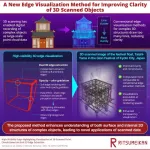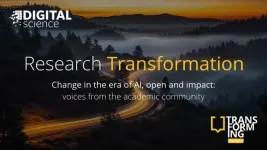(Press-News.org)
Recent advances in three-dimensional (3D) scanning, particularly in photogrammetry and laser scanning, have made it possible to quickly and accurately scan complex 3D objects in the real world. These techniques generate detailed models by collecting large-scale point cloud data, representing the object's surface geometry through millions of individual points. This technology has applications in different fields, such as the 3D scanning of cultural heritage objects. By preserving these objects in digital formats, researchers can analyze their structures in greater depth. However, the complexity of data is often significant, especially when the scanned object has internal 3D structures, like rough edges.
Edge-highlighting visualization is a technique used to improve the clarity of complex 3D structures by emphasizing the object's edges, making its shape and structure more distinguishable. However, existing methods struggle when applied to highly complex objects. These methods draw too many lines, which decreases clarity by impairing resolution and depth perception.
To address these challenges, a multinational team of researchers, led by Professor Satoshi Tanaka, along with colleagues Ms. Yuri Yamada, Dr. Satoshi Takatori, and Prof. Liang Li from the College of Information Science and Engineering at Ritsumeikan University, have developed an innovative method. Elaborating on their study, Prof. Tanaka explains, “Conventional methods for extracting and visualizing 3D edges mainly concentrate on sharp edges. However, many real-world objects contain numerous soft edges in addition to sharp edges, which are inadequately represented. Our method introduces two key innovations: dual 3D edge extraction, which separately extracts both soft and sharp edges, and opacity–color gradation, which enhances the clarity of soft edges through variations in color and opacity.” These findings were published in Remote Sensing on October 09, 2024.
This novel visualization method is based on dual-edge 3D edge extraction and opacity–color gradation. Dual-edge 3D extraction technique independently processes the sharp and soft edges of a 3D object by utilizing two different feature value thresholds for sharp and soft edges. Meanwhile, the opacity–color gradation technique applies simultaneous gradation of both opacity and color to soft edges. This process renders soft edges with sharper and thinner lines, effectively highlighting the complex and intricate details of 3D structures. Additionally, it introduces a “halo effect” that partially hides edges in the background of the image, significantly enhancing depth perception. This effect also improves the resolution of sharp edges by highlighting their silhouettes with soft edges.
The researchers tested this technique by applying it to real 3D point cloud data, including cultural heritage objects with high cultural value. Results revealed that the proposed edge-highlighting visualization technique produces a clear, comprehensible representation of the entire 3D structure. Remarkably, the computation time required for dual-edge 3D extraction is comparable to conventional binary statistical edge extraction methods, while visualizations in opacity–color gradation are executable at interactive rendering speeds. Furthermore, this technique offers a more effective “see-through” effect, replacing the conventional transparent visualization used to study internal structures of 3D objects. Additionally, applying this technique to conventional transparent visualization is effective as well.
“Our 3D edge extraction approach is not merely an improvement but rather an extended technique that captures areas not covered by traditional methods. For archaeologists and historians, this tool opens new possibilities for specialized visual analysis of cultural heritage objects. For the general public, it offers a deeper understanding of historical cultural sites, serving as a technology for enhancing exhibitions in museums and art galleries,” says Prof. Tanaka about the potential of their research.
This innovative technique significantly advances the visualization of 3D scanned objects, promoting a better understanding and preservation of cultural heritage objects.
***
Reference
DOI: https://doi.org/10.3390/rs16193750
About Ritsumeikan University, Japan
Ritsumeikan University is one of the most prestigious private universities in Japan. Its main campus is in Kyoto, where inspiring settings await researchers. With an unwavering objective to generate social symbiotic values and emergent talents, it aims to emerge as a next-generation research university. It will enhance researcher potential by providing support best suited to the needs of young and leading researchers, according to their career stage. Ritsumeikan University also endeavors to build a global research network as a “knowledge node” and disseminate achievements internationally, thereby contributing to the resolution of social/humanistic issues through interdisciplinary research and social implementation.
Website: http://en.ritsumei.ac.jp/
Ritsumeikan University Research Report: https://www.ritsumei.ac.jp/research/radiant/eng/
About Professor Satoshi Tanaka from Ritsumeikan University, Japan
Dr. Satoshi Tanaka is currently a Professor at the College of Information Science and Engineering at Ritsumeikan University. He obtained his M.S. and Ph.D. degrees from Waseda University in 1982 and 1987, respectively. In addition to being a fellow of the Ritsumeikan Advanced Research Academy (RARA), he is also a member of the Kinugasa Research Organization Art Research Center and the Research Organization of Science and Technology Research Center of Advanced ICT for Medical and Healthcare. He has over 1,700 publications with over 100,000 citations. His research interests include computer graphics, scientific visualization, digital humanities, and medical visualization.
Funding information
This research is supported by JSPS KAKENHI (Grant Number 21H04903) and Fundamental Research Funds for the Central Universities (Grant number FRF-IDRY-23-001).
END
As urban areas expand, the threat of natural disasters becomes a pressing concern for city planners and disaster management authorities. In earthquake-prone countries like Japan, one of the critical risks to infrastructure is liquefaction, a phenomenon where intense shaking causes loose, water-saturated soils to lose their strength and behave like a liquid. Liquefaction can cause buildings to sink into the soil, crack foundations, and collapse roads and utilities like water lines.
Soil liquefaction accompanies every major earthquake, and the damage is significant. The 2011 Tōhoku earthquake in Japan caused liquefaction ...
Metal peroxide (MO2, M=Ca, Sr, Ba) is an alternative to hydrogen peroxide (H2O2). It has excellent oxidative properties, superior chemical stability, high purity, and is easy to store and transport. It has been widely used in wastewater treatment and disinfection.
A Chinese research group has recently developed a novel self-cleaning electrode by constructing a micro-/nanostructure of a highly active catalyst with appropriate surface modification, achieving highly stable synthesis of alkaline-earth MO2.
This study was published in Nature Nanotechnology.
The current primary synthesis process of MO2 involves fast decomposition of H2O2, leading to insufficient utilization ...
Digital Science, a technology company serving stakeholders across the research ecosystem, is today calling for greater awareness of the impact that a myriad of fast-developing technologies are having on academics and their institutions.
This follows the publication of a new report from Digital Science looking at how changing attitudes and behaviors towards research are affecting traditional research models and dynamics. Key themes to emerge from the findings relate to areas of open research, impact and evaluation, tech and AI, collaboration and research security.
The objective of the report – titled Research Transformation: Change in the era of AI, open and impact ...
Researchers from the University of Oxford have identified a key biochemical mechanism relevant to the development of Huntington’s Disease. This discovery opens up the possibility of studying the disease before its clinical onset and eventually stopping its progression.
The study, published in Nature Metabolism, has shown for the first time the biochemical change responsible for the development of Huntington’s disease, and how blocking this change stopped disease progression.
Huntington's disease is an inherited condition that stops parts of the brain from working properly, leading to mental and physical decline that slowly ...
The potential of human-AI collaboration has captured our imagination: a future where human creativity and AI's analytical power combine to make critical decisions and solve complex problems. But new research from the MIT Center for Collective Intelligence (CCI) suggests this vision may be much more nuanced than we once thought.
Published today in Nature Human Behaviour, “When Combinations of Humans and AI Are Useful” is the first large-scale meta-analysis conducted to better understand when human-AI combinations are useful in task completion, and when they are not. Surprisingly, the research has found that combining humans and AI to ...
Researchers at UCLA Health have found that a person's risk of developing psychotic-like experiences may be influenced by both childhood attention problems and their genetic makeup.
The findings, published in Nature Mental Health, build upon a long-studied association between childhood attention problems and the likelihood of later developing schizophrenia. Using data from about 10,000 children over six years, UCLA researchers led by Dr. Carrie Bearden sought to determine how attentional variability ...
It is well known that acting quickly in the event of a cardiac arrest is important, but what does a quick initial shock with a defibrillator mean exactly for patients' chances of survival? Researchers from Amsterdam UMC analysed the data of 3723 patients who had a cardiac arrest outside the hospital and concluded that for the first shock, every minute reduces the chance of survival by 6%. The results of this research were published today in the international journal Circulation.
"Our research shows that every minute of delay in giving the first shock has a major impact. If the first shock was given within six minutes, it was possible ...
An abnormal BMI in children – be it high or low – can now be associated with impaired lung function, but if their BMI is normalised before they reach adulthood, the impairment can be offset, researchers from Karolinska Institutet report. Their results, which are based on data collected under the BAMSE project in Sweden, are presented in The European Respiratory Journal.
One in ten people have reduced lung function development in childhood and cannot achieve maximal lung capacity in adulthood, increasing the risk of serious health problems such as cardiovascular disease, lung disease and diabetes. One risk factor associated with impaired lung function development is abnormal ...
Imagine you decide to write a short story about a protagonist who creates an artificial human and then falls in love with it. What gender is your protagonist? What about the artificial human? Would you write a moving love story? A cautionary dystopian tale?
Would your story be more compelling than one written by ChatGPT?
Likely yes, says Nina Beguš, a researcher and lecturer in UC Berkeley's School of Information and Department of History. Leveraging her background in comparative literature ...
A new study from Karolinska Institutet shows that heart failure mortality has decreased in Sweden over the last 20 years. The study has been published in the European Journal of Heart Failure.
A national study has shown that heart failure mortality has decreased in Sweden over the last two decades. Despite these improvements, the prognosis for heart failure patients remains worrying – 25 percent of those diagnosed in 2022 died within a year.
“Our results suggest that advances in heart failure treatment over the past decades have reduced heart failure mortality, both at the population level and for individual patients. ...




